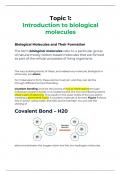Topic 1:
Introduction to biological
molecules
Biological Molecules and Their Formation
The term biological molecules refer to a particular group
of natural mostly carbon-based molecules that are formed
as part of the cellular processes of living organisms.
The very building blocks of these, and indeed any molecule, biological or
otherwise, are atoms.
For molecules to form, these atoms must join, and they can do this
through different forms of bonding.
Covalent bonding involves the joining of two or more atoms through
individual covalent bonds. In a covalent bond, the two contributing atoms
share a pair of electrons. This results in the outer shells of the two atoms
creating a permanent bond. A covalent molecule is formed. Figure 1 shows
this in action using water, and H2O as the example. You can see the
sharing of
Covalent Bond – H20
electrons between the oxygen atom and the two hydrogen molecules.
,Ionic bonding, by contrast, involves the transfer of electrons from one of
the contributing atoms to the other. In this case, the atoms need to
become positive or negative ions (by loss or gain of electrons) and then it is
these oppositely charged ions that seek to complete their outer shell of
electrons by donating or accepting and thus forming an ionic bond.
An excellent example of this is Sodium chloride, NaCl or common table
salt. Figure 2 shows the two ions involved, Na+ and Cl- the transferral of
one electron from the outer shell of the sodium ion to the chloride ion and
the formation of the bond.
Intermolecular forces are not strictly bonds in the truest sense of the word,
but they are the interaction, not between positive and negative ions, but
between slightly positively and slightly negatively charged “areas” of two
molecules, which creates additional attraction and strength in the
substance. These regions within a molecule come about due to the
uneven distribution of electrons within it.
Water, for example, H2O, is composed of two hydrogen atoms bonded
to one oxygen atom. In this molecule, the electrons are drawn towards
the more electronegative oxygen, which creates a negative charge at
the oxygen end of the molecule and a more positive charge at the
hydrogen end.
Figure 2 – The shape of bonding in water. Notice how the hydrogen
and oxygen atoms occupy "sides" of the molecule.
,The specific attraction between oxygen in one water molecule and
hydrogen in another is a particular type of intermolecular bonding called
hydrogen bonding. This is a crucial property of the water molecule and
the accumulation of many of these hydrogen bonds within an amount of
water creates a tangible effect and allows water to possess some of its
unique and life-supporting properties as a substance.
Activity
Cl2
A chemical bond involving the sharing of electron pairs between atoms is known as a covalent bond.
Chlorine (Cl) has an atomic number of 17 so its electronic configuration [Ne]3s 2 3p5. So, chlorine has 7 valence
electrons.
To complete its octet, each chlorine shares its one electron and a chlorine molecule (Cl 2) having a covalent
bond is formed.
The formation of chlorine molecules is shown below:
HCL
HCl, also known as hydrochloric acid, has a covalent bond.
Hydrogen (H) has an atomic number of 1 and Chlorine (Cl) has an atomic number of 17 their electronic
configuration is as below:
[H] 1s1 and [Ne] 3s² 3p⁵
The formation of chlorine molecules is shown below:
O2
O2, also known as Oxygen, has two covalent bonds.
Oxygen (O) has an atomic number of 8 so its electronic configuration is as below:
[He] 2s² 2p⁴
, Water
Water is formed through the grouping of a hydroxyl (-OH) from one
monomer and a hydrogen (H) from another monomer.
A condensation reaction is a reaction that occurs when two molecules
combine to form a more complex molecule with the removal of water.
Hydrolysis reactions break the bond between individual monomers which
requires a molecule of water between the bond to be able to do this.
While hydrogen bonding is most associated with water and the attraction
between hydrogen and oxygen atoms, this phenomenon can occur
between hydrogen and several highly electronegative atoms like nitrogen,
and the most electronegative atom known, fluorine.
Monomers & Macromolecules
Many biological molecules are large, consisting of long, often
complicated chains of atoms.
While the atom is the quintessential building block of chemistry, these
large molecules, given the general name, macromolecules, are often
composed of a series of set components.
The parts come from smaller molecules known as monomers that can be
easily linked to each other, to ultimately form these long-chain
macromolecules or polymers.
You might be familiar with some of the polymers found in textiles or
plastics and packaging, like nylon, polyester, or polystyrene. These are
composed of small units, like styrene as in the (poly)styrene shown in
Figure 4.





